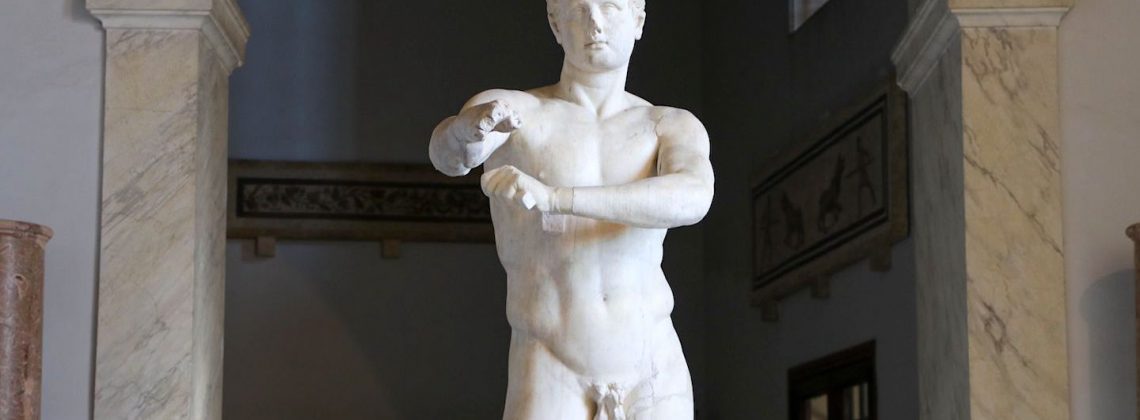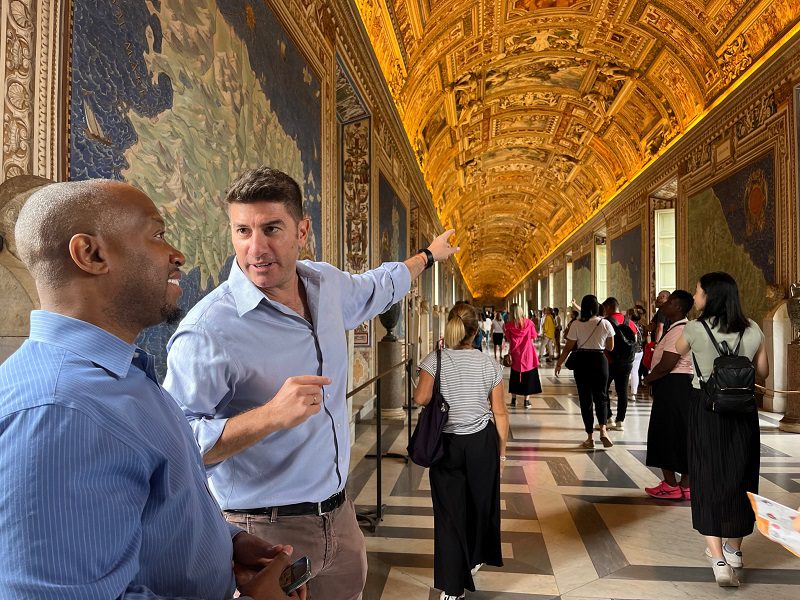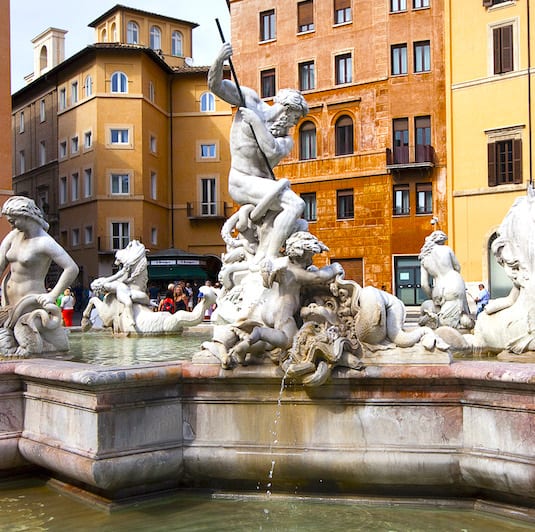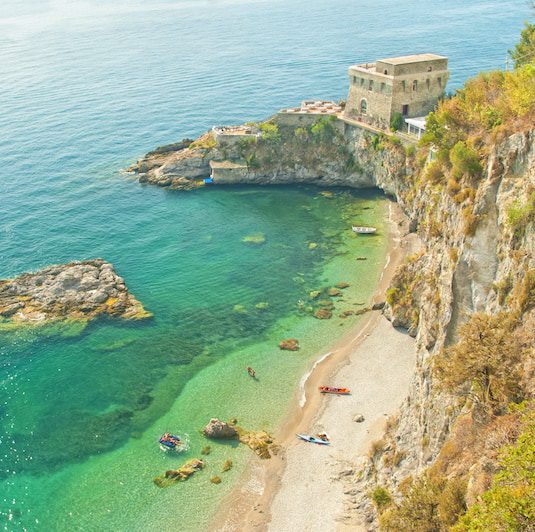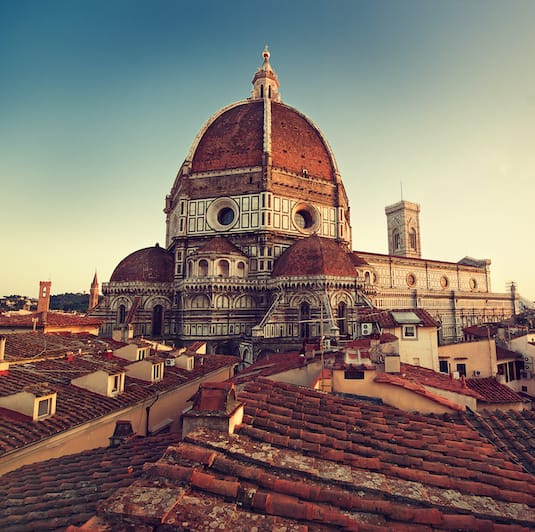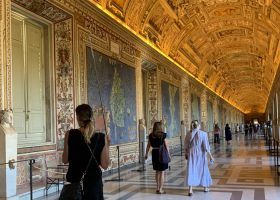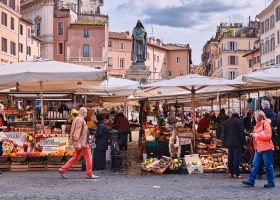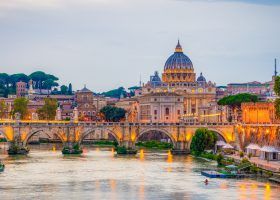The Vatican is home to thousands of works of art. Among all of its beautiful spaces, the Vatican’s biggest exposition area is the Pio Clementino Museum. In this guide to the top things to see in the Pio Clementino Museum, discover its history a little bit better and see what this space has to offer.
Pro Tip: Planning your visit to the Vatican in Rome? Bookmark this post in your browser so you can easily find it when you’re in the city. See our comprehensive guide to Vatican City for more planning resources, our top Vatican tours for a memorable trip, and how to visit the Vatican.
What To See at the Pio Clementino Museum
The Pio Clementino Museum is spread across a number of large exhibition halls. They were converted to accommodate the pope’s expanding collection of classical sculptures. Today, it houses some important works of art inside the Vatican Museum.
We’ll start with a brief history of the museum. Then you’ll see a list of major works you can’t miss at the Pio Clementino Museum. You can also check out the video below for the top things to see at the Vatican. The Pio Clementino Museum is featured at number six, and you’ll get a preview of this beautiful space.
The Pio Clementino Museum is just one area of the Vatican Museums you can visit. As you plan your visit, check out our ultra-comprehensive list of what to see at the Vatican, written by a licensed Vatican guide.
Not ready to book a tour? See if a Vatican tour is worth it.
History of Pio Clementino
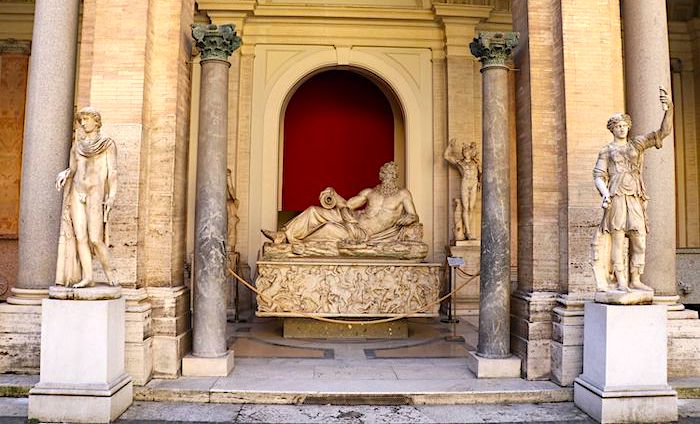
Pope Clement XIV first created these rooms in 1771. He had previously acquired different collections from various Italian families and needed more space to display them all. However, Pope Clement’s successor, Pope Pio VI, decided to modify and improve the space by adding some monumental entrances to the complex.
The total space today contains 12 different rooms that showcase priceless works of art. The collection of classical statues you’ll see in these galleries was started at the beginning of the 16th century by Pope Julius II.
The Pio-Clementino Gallery, however, was named for the later popes Clement XIV (1769 to 1774) and Pius VI (1775 to 1799) who created the current galleries you’ll walk through. Much of the artwork here was taken by Napoleon but brought back to the museum after his defeat.
9. The Apoxyomenos Room
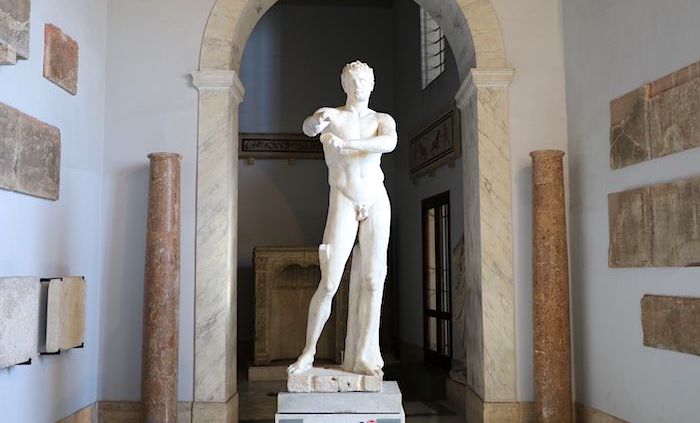
How perfect would this statue be in a commercial for Bed, Bath, and Beyond? Apoxyomenos literally means “to clean oneself” and that is exactly what the portrayed athlete is doing. Back in the day, athletes would clean themselves by rubbing oil into their skin. They would then apply dust and scrape it off with a curved instrument called a strigil.
According to the Vatican Official Archives, “The statue is a Roman copy from around A.D. 50 of an original Greek bronze sculpture by the great Lysippus from around 320 B.C. Of particular note is the motion of his foot in the air and also the extension of the arm which creates space and gives depth to the sculpture.”
The Ancient Greeks knew about soap but limited it to washing clothes. Both ancient Greeks and Romans used to rub their skin with oil and pulverized pumice stone, then remove it using a strigil.
Enrico Bruschini, Art Historian and Official Vatican Tour Guide
8. The Octagon Yard: the Apollo del Belvedere

The Apollo Belvedere arrived at the Vatican in 1508. It was owned by Pope Julius II before he was even pope. Like many popes before him, he brought all his artwork with him into his new home, the Vatican, upon ascending to the purple. In the statue, the sun god Apollo has just let go of an arrow and is watching where it will land.
This particular statue is a Roman copy from the mid-second century A.D. of an original Greek bronze statue by Leochares from around 320 B.C. The exquisite hairstyle and flowing cape are remarkable details for that period. The Greek writer Pausanias wrote that this beautiful statue once adorned the Agora, Athen’s main square.
Interesting Fact
If you look closely at the face of Apollo, you’ll see a resemblance to Jesus Christ in the Last Judgement by Michelangelo. He would have studied these statues and used them as inspiration for his own works.
Of all the works of antiquity that have escaped destruction, the statue of Apollo represents the highest ideal of art.
Johann Joachim Winckelmann, 18th-Century Art Historian
Popular Vatican Tours
Best Selling Tour
Privileged Entrance Vatican Tour with Sistine Chapel
Without the right access, visiting the Vatican means fighting crowds, long waits, and missing the most significant rooms and works of art. Our privileged entrance tour offers more than just entry—it’s an immersive experience led by a storytelling guide who brings the Vatican to life. Skip the line and explore the Vatican Museums, including the Raphael Rooms and the Sistine Chapel, with engaging insights that make each moment memorable and meaningful.
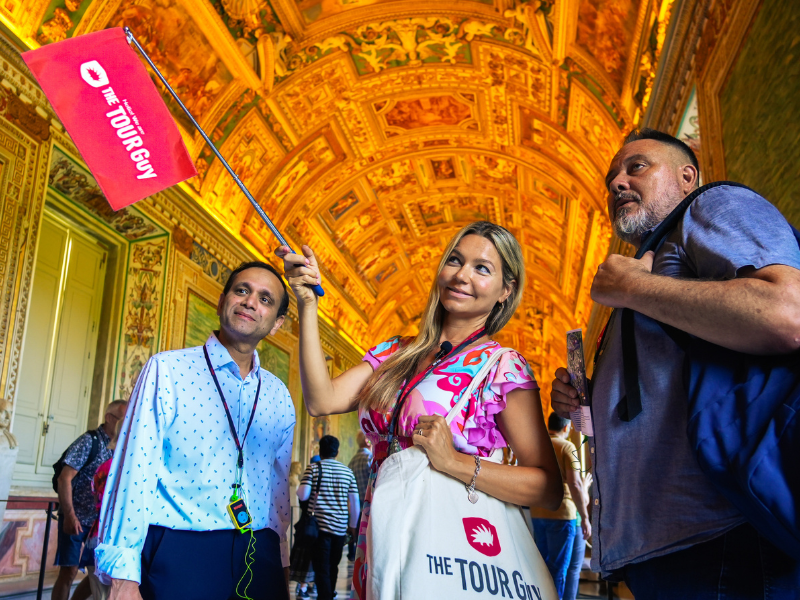
Exclusive Value
Vatican at Closing Time with Sistine Chapel
Exploring the Vatican during the day can mean massive crowds and enduring long lines. With skip-the-line access and an engaging guide, you’ll uncover the captivating stories behind the galleries and enjoy the awe-inspiring beauty of Michelangelo’s Sistine Chapel in a serene setting. Your friendly guide offers a rare perspective, allowing you to experience the Vatican Museums after most visitors have left, making your visit truly extraordinary.
See Prices
Not ready to book a tour? Check out our best Vatican tours to take and why.
7. Laocoön and His Sons
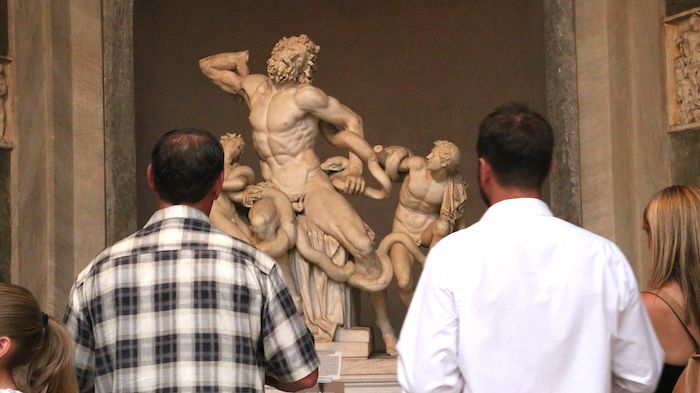
If you’re a Star Wars fan, the Laocoön might remind you of Han Solo when he was frozen in carbon for Jabba the Hut. The sculptor was able to capture the precise moment of agony.
The statue was discovered on Esquiline Hill in 1506 and Pope Julius II was immediately informed. It is believed to be an original Greek statue made around 40 B.C. Once uncovered, they identified the statue right away as the Laocoön Group of statues made by sculptors on the island of Rhodes.
This work represents a story from the “Aeneid” by Virgil. In the story, the Trojans believed the war to be over when they received the Trojan horse from the Greeks. The priest Laocoön was the exception and warned that the horse would be their downfall. Athena, who sided with the Greeks, sent two serpents to kill the priest and his two sons, quieting them forever. The rest is history.
Interesting Fact
When they found the statue, it was missing its right arm. Many artists made their own renditions of the arm, depicting it pointing straight up in the air. Michelangelo looked at the body movement and realized that the arm should be bent.
A Swedish archeologist discovered the original arm in the 17th century, and guess what it looked like? The arm bent just as Michelangelo had imagined it. Supposedly, the museum connected Michelangelo’s arm to the back of the statue and it’s still there today. But this remains to be confirmed.
6. Sarcophagus of Saint Helena
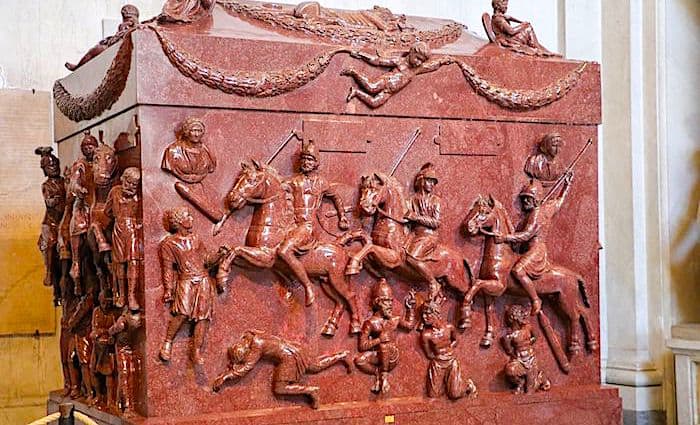
This is a rather masculine sarcophagus considering it was used for a famous woman in history. Helena was the mother of Emperor Constantine the Great and died in A.D. 335. She was buried in a mausoleum dedicated to her in Tor Pignattara, which is on the via Casalina outside the city of Rome.
The sarcophagus you see above is made of red porphyry, which was the color reserved for emperors. The military-themed decorations would have been quite strange for a woman’s tomb. This has led scholars to believe that the resting place was originally created for a man, possibly Constantine’s father or Constantine himself.
In 1777, the sarcophagus was brought to Rome and restored by Gaspare Sibilla and Giovanni Pierantoni. It was at this time that it was mounted on top of four lions carved by Francesco Antonio Franzoni.
Helena was a devout Christian, even before Constantine had won the battle at the Milvian bridge or legalized the religion itself. In fact, she may have had serious influence over Constantine and his religious beliefs. She led a pilgrimage to the Holy Land where she established the tomb of Jesus Christ. Thereafter, under the orders of Constantine, the church of the Holy Sepulcher was built.
5. The Sculptures Gallery: the Mattei Amazon
Another classical artwork showcased in the Pio Clementino Museum is the Mattei Amazon. It is a work inspired by the Greek artist Phidias. Originally, the Mattei family owned this statue and the Vatican later acquired it in 1771, when Pope Pius XIV decided to buy their entire collection.
Unfortunately, some pieces of the sculpture have been lost over the centuries. According to classical sources, this work should have portrayed an Amazon while climbing her horse and, probably, holding a spear.
4. Nero’s Bathtub
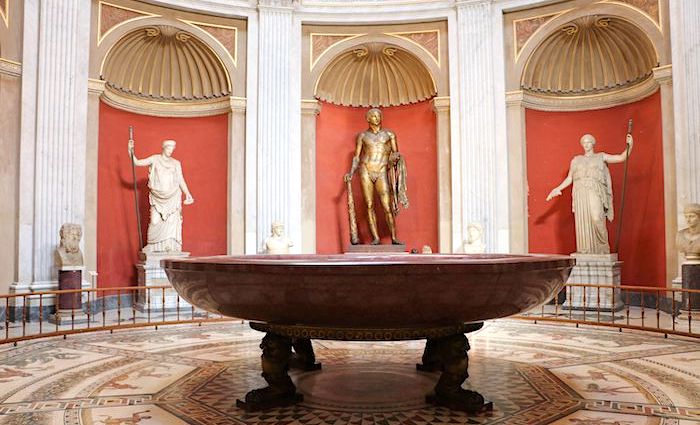
This impressive piece of stone is made from a purple marble called Red Porphyry. The stone originates from Egypt and was the most highly-prized stone, reserved for the emperors. The color purple was the most prized due to its scarcity.
In order to collect one gram of purple dye, they had to extract it from 10,000 sea snails. That’s why when the Romans found this stone, they collected every available bit of it.
The so-called Bath of Nero was more likely to be a fountain than an actual bath. It was found at Nero’s house, the Domus Aurea, over on the Esquiline hill and brought over to the Vatican.
Stories circulated of Nero’s tyranny and eccentric behavior and so, over time, a rumor started about this being his actual bathtub. We’ll never truly know what it was used for. However, we can say for sure it is a beautiful piece of marble.
3. The Masks Room: the Aphrodite of Cnidus
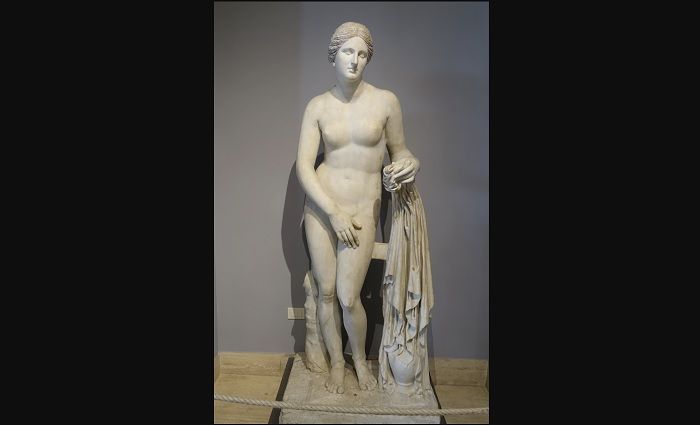
According to history, the Greek sculptor Praxiteles created the original Aphrodite. Today, we can admire the best copy of this masterpiece in the Pio Clementino Museum. This sculpture represents the goddess Aphrodite as she’s about to take a bath.
Aside from the classical beauty and harmony of this statue, its importance is in the fact that for the first time in history a woman was portrayed naked. This completely changed the art history world. For centuries, artists have studied this statue as its “S” shape is still considered the best-portrayed body of all time.
Popular Rome Tours
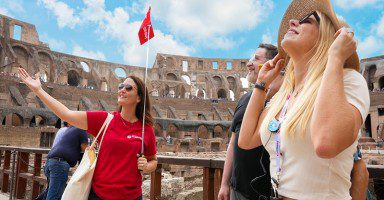
Best Selling Tour
Rome in a Day Tour with Colosseum and Vatican Museums
Seeing the best of Rome in a single day might seem like a big undertaking, but our expertly designed tour makes it effortless with skip-the-line tickets, included transportation, and engaging guides to lead the way. In just 7 hours, you’ll visit renowned sites like the Sistine Chapel, Colosseum, Trevi Fountain, and Pantheon. With fascinating stories at every stop, you can skip the stress and immerse yourself in the vibrant heritage and culture of Rome all in one remarkable day.
See Prices
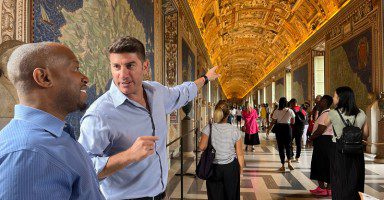
Best Price!
Privileged Entrance Vatican Tour with Sistine Chapel
Without the right access, visiting the Vatican means fighting crowds, long waits, and missing the most significant rooms and works of art. Our privileged entrance tour offers more than just entry—it’s an immersive experience led by a storytelling guide who brings the Vatican to life. Skip the line and explore the Vatican Museums, including the Raphael Rooms, the Sistine Chapel, and St. Peter’s Basilica with engaging insights that make each moment memorable and meaningful.
See Prices
Not ready to book a tour? Find out if Rome tours are worth it.
2. The Muses Room: the Belvedere Torso
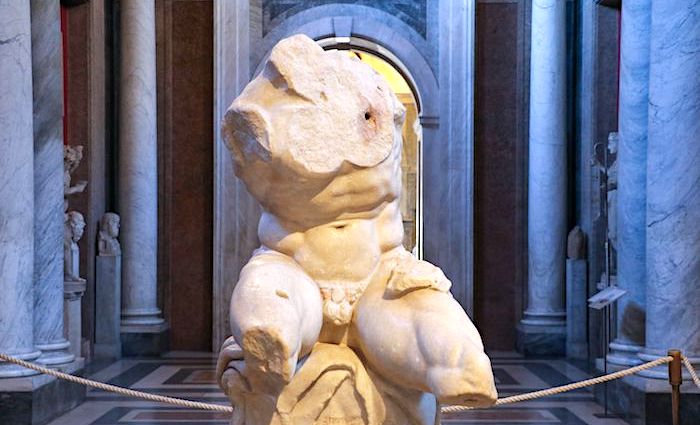
Many are surprised when they walk into this room and find just a torso by itself. Why would the Vatican feature a statue with no head, hands, or feet right in the middle of a room? In modern times, we take for granted all the resources we have to aid us in understanding anatomy.
The magic of this statue is that the body is in motion. Contorting to his left, all of his muscles complement the movement perfectly. This indicates that the sculptor had intimate knowledge of anatomy. This was a big deal even in the Renaissance period since it was forbidden to dissect humans to study muscles and anatomy.
This statue was found in the late 15th century and was in the Vatican collection by 1530. It would be a marble copy of an original bronze made sometime in the mid-second century B.C.
While the exact figure is unknown, many believe it to be Ajax contemplating his suicide after losing the competition with Odysseus from the Iliad. We do know the name of the sculptor because he engraved this statement on the statue: Apollonios, son of Nestor, the Athenian, created it.
Interesting Fact
Michelangelo displayed his admiration for this statue repeatedly in the Sistine Chapel. In the Chapel, the angels around each ceiling painting, are curving their bodies in the same direction as the torso.
In his Last Judgement, St. Bartholomew’s body also contorts to a degree in a similar fashion. In his twilight years, practically blind, he was said to visit the statue regularly and just run his hands over the muscles.
This is the work of a man who knew how to do it better than nature.
Michelangelo
1. The Round Room: Hercules from Pompey’s Theatre
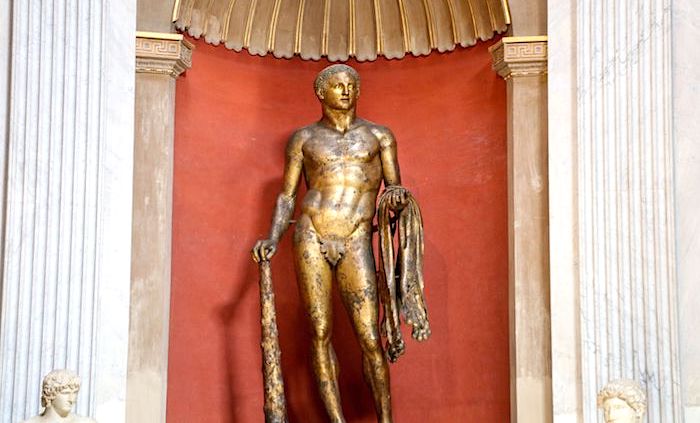
Back in the day, the Romans often melted down bronze statues to recycle the metal. So, it’s truly a gift to find an ancient statue in bronze. This gilded Hercules has large staring eyes and curly hair. Archeologists found the statue in 1864 under a courtyard near Campo de’ Fiori not far from the Theater of Pompey where Julius Caesar was assassinated.
The statue was then given to Pope Pius IX (1846-1878) and that’s how it came to be in the Vatican today. It’s easy to identify Hercules due to the Nemean lion skin draped over his arm, the club he rests on, and the apples of the Hesperides in his left hand.
The statue has been dated with a few different dates ranging from the first to the third centuries A.D. Historians point to the style as being copied from the Neo-Attic style of the fourth century B.C.
Interesting Fact
When they found Hercules, it was lying on its back with a slab of travertine stone on top of it like a burial. On top of the slab of stone the following letters were carved: F C S for Fulgur Conditum Summanium. The statue had been struck by lightning and since Hercules was the son of Zeus, the ancient Romans took that as a sign that the statue should be properly buried together with the remains of a lamb.
Vatican Tours with Pio Clementino Museum
Supposedly, if you stand in front of each art piece for one minute in the Vatican Museums, it would take you 12 years to see everything. How incredible is that! While it’s certainly possible to visit the museums on your own, I highly recommend you join a tour guide.
Not only will a tour guide get you skip-the-line access, they’ll also guide you through the Vatican Museums quickly. Your guide will get you in and out before you go into overload without missing anything important.
Best of all, you’ll hear all the intriguing stories and history that make this museum and its collections so fascinating. It’s an added layer that will make your Vatican visit all the more meaningful.
There are lots of Vatican tour options to suit your interests and schedule, compare our best Vatican tours. In most of our Vatican tours, you’ll see the Pio Clementino Museum up close, so check them out and reserve your spot!
Not ready to book a tour? Find out if a Vatican tour is worth it.
Here’s Where To Stay in Italy’s Most Popular Destinations
Rome, Florence, Venice, Amalfi Coast, and Capri

